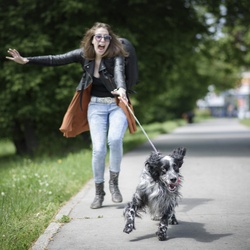
Do you want to learn some dog walking tips and tricks? Do you find yourself complaining to fellow dog owners that your dog pulls you on its walks? Do you have hurt arms and shoulders?
More...
Basic Dog Walking Tips
Dog owners are sometimes unaware of the factors that can affect their dog’s behavior.
Dog walking tips, such as these, can help you adjust your dog's behavior on your next walk.
Moreover, these dog walking tips will provide valuable information for all dog owners who want to have a good relationship with their pets and make sure they are happy and healthy.
Dog training starts at home and, more precisely, when the dog is young. Also, it is imperative to teach your dog to walk appropriately on a leash.
We can not stress the importance of dog walking enough. When your dog is leash trained, it is a lot more tolerant of being walked and less likely to pull.
Also, regular exercise makes your dog more agile and healthy. Furthermore, dog walking can help improve your dog's mental wellbeing and can stimulate its brain, especially if you have an older dog.
In this post, we will discuss a few tips to help your dog become a better canine citizen on his walks.
In addition, at times, we will refer to the dog as “it” to make no difference between a male or female dog.
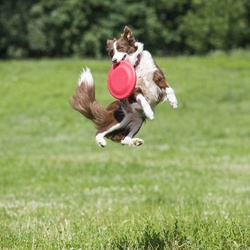
Regular Exercise
Your dog has to have regular, consistent exercise. Thus, learning how to train your pup to walk on a leash is imperative.
Dogs with regular exercise are probably happier and more well-behaved than other dogs left unattended for more extended periods.
As a result, daily walks are enjoyable and refreshing for you and your dog.
All dogs of any size have to get exercise. If not, then you will begin to see a pudgy pooch.
Dogs like humans get happy when they get exercise. Dogs look forward to walking, running, jumping, playing, and eating.
Do you ever notice how cheerfully he wags his tail or barks when you ask him if he wants to go outside?
Yes, this is the part of the day that your pooch has been waiting for you to ask him. Once out, make the experience happy for your dog.
Your dog will look forward to its daily outings if you walk it consistently.
Your dog has to learn manners and respect during the walk or at any other time for that matter. With this in mind, your hikes will be enjoyable and not apprehensive.
Private Training
The proper thing for you to do before taking your dog around other humans or animals is to train the dog privately.
You can set up a walking course in the backyard.
The dog is less unmindful. After your buddy calmly walks beside you on its leash, then it is time for the two of you to step outside with the public.
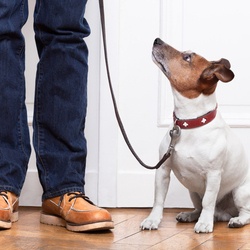
Training Starts at Home
Dog obedience and training start at home. If your dog has a bit of training and understands the “Stay” command, then you can say that command and walk out of your house first.
If your dog tries to go before you, gently correct it with a solid “NO” and have him go back inside your home.
You may have to repeat this a few times to make your dog understand that you always lead first.
You are the leader. With that said, that means that you leave the house first.
You should train your dog to sit at the door with it open, sit and wait until you leave the house first.
When you go first, then say "OK," your dog can follow you at that moment.
At this instant, this begins the walk on a good note. If you allow an excited dog to leave the house out to an exciting outdoors, then you will possibly give up control of the entire walking experience.
Hence, as you return home, your dog should enter the home calmly, and the leash should come off in a like manner.
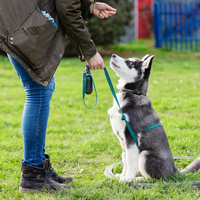
Leash Training
The appropriate way to walk a dog on a leash involves you being in charge as the pack leader of the outing and not your dog.
Indeed, learning how to walk your dog on a leash is both enjoyable for you and your dog.
Your dog should remain calm when you reach for its leash.
Simply put, the leash is a treat implying that the dog gets to leave the house and go outside.
If you train your dog in this manner, then in this way, it is a reward for the dog.
Calmly put on your dog’s collar and then attach the leash. Pick up the leash and stimulate your dog to walk appropriately at your side.
The collar should be placed high up on its neck so that you have control over your dog.
Essential to realizing is that a leash high on the neck will enable you to properly manage your dog with the least resistance.
If your doggy fidgets around as you clip on the leash, stop and stand back until it is quiet the entire time of putting on its leash.
You do not give your dog the leash reward until it is calm.
Pulling Is Not an Option
Why do dogs pull on the leash? The reason they pull may be because you are pulling them back.
Therefore, the only way to train them not to pull is for you to teach them to slow down.
It would be best if you had a leash, preferably 6 ft. Moreover, the leash should be comfortable and feel good in your hands.
There should always be some slack on the leash. Make sure the dog walks next to you on the walk.
Your dog has to understand that pulling is not an appropriate action on its part. For this reason, you have to have a great deal of patience and endurance.
If your dog gets ahead of you, then use your leg, place it in front of the dog, and firmly say “No.”
You will experience enjoyable walks once you train your canine to walk next to you accurately from this perspective.
After your dog has walked next to you without tugging, put the leash down and acknowledge her wanted behavior. Rinse and repeat.
You strengthen your role as the one in charge of the pack with proper and correct leash training.
You have to train your dog to walk beside you on a loose leash so that both you and your dog enjoy the walk.
In contrast, a snug leash may make it harder to manage your dog.
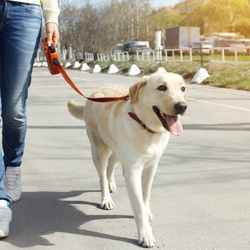
Fido Must Walk Beside You
You want to be the pack leader. With these dog walking tips, you will learn how to command your dog to walk beside you and not in front of you by using clear commands and staying confident.
You are the alpha and the leader, and your dog has to walk next to you, not in front and not pulling you.
You should train your dog to walk on your left side with her head leveled to your leg.
If she lags back, slap your leg to get her to focus and catch up with your pace.
The dog's legs should line up with your legs, and you should have some slack on the leash so that your dog isn’t pulling and tugging you on the walk.
If you allow your dog to walk in front of you, then it thinks that he’s in charge of you.
You train your dog to not pull on the leash; if it does pull, then correct the situation quickly by popping the leash to get its attention and focus on the calm walk.
If your dog begins to act up, stop and make it sit. Once it has calmed down and its focus is back on you, the walk can continue. You may have to do this a few times during training.
Training is the best thing ever! Dog owners can now control their pets by teaching them to walk beside them, no more pulling and tugging on the leash or being dragged across the ground.
You Are the Leader
The problem with the dog walking in front of you lets it know that it is the leader and not you. What you are teaching him is that it is ok to lead you.
Consequently, you let it get away with whatever it wants to do, and you are rewarding its behavior by not correcting the situation immediately.
Why would it ever stop its behavior if you ignore the unwanted behavior by not fixing the problem?
As you walk your dog, it should never cross your path while walking.
If the dog has to go to your other side during the walk for some reason you determine, it should walk behind you as it crosses to the other side.
Now, if the dog happens to cross in front of you, say ”NO” firmly and guide it to the other side.
Always note that consistency is essential during training. Your dog will understand and get the point to cross behind and not in front of you in time.
By adhering to the above suggestion, you will prevent your dog from tripping you during future walks.
Change Directions
A good tip is to change the direction of travel when your dog is not anticipating it. By doing this, you will train your dog to pay attention consistently to you. Also, changing course is an excellent way to stop the dog from pulling.
Now, if your dog is getting ahead of you on the leash, don't worry! Just turn around and head in a different direction.
If you time this correctly, your dog will not receive the chance to pull you. In like manner, your arms will stay relaxed as you turn your dog in a different direction with minimal effort on your end.
Keep changing direction each time your dog is about to pull ahead, and it will begin to understand that pulling isn’t a helpful way to get to its destination.
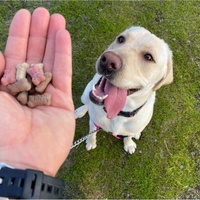
Praise Rover
Make sure to praise her when her head is in the correct position. You can give her some treats for her positive behavior.
It is crucial that you only reward her when her head is at the right level to your leg, not in front, not in the back, but besides your leg.
If her head starts to wander, call her name to bring her head to the correct position to your leg.
If she starts to pull on the leash, by all means, tug the leash or stop walking to gain her attention.
As soon as she stops to look to see why you stopped, pat your leg so that she realizes that she is to come back leveled to your leg.
You might want to give a command like “Come,” so she acknowledges an order to come back next to your leg.
The next time your dog starts to pull ahead of you, repeat the same procedure: give a quick tug on the leash and praise her when she walks calmly by your side.
Distractions
A lot of dogs love to chase moving things! When you combine the endless energy, curiosity, and intelligence of these furry friends with a lifelong instinct to pursue moving objects, it can be hard for them to resist.
With this in mind, this is when the leash is handy to help keep your dog focused on the activity at hand.
The leash gives you control of your dog. In any event, you have to train it away from the distractions through treats or waiting until it calms down through sitting.
At any rate, you have to have patience and stay calm and not make him anxious with your frustrations.
While on your walk, your dog may encounter loud noises. With that said, some dog's instincts are to run and go in the opposite direction.
If this is the case for your dog, you have to train your dog to stand in one spot to calm down and relax.
Your goal is to make sure that your dog isn’t afraid of everything and make it face its fears while out and about! Training will take time and patience.
Confidence
Your dog can sense your body language. Therefore, the tone for you as you walk your dog is to keep your head up, shoulders back, confident, and staying calm.
You’ll notice as your confidence improves, you will find it easier to take it easy even when additional challenges emerge while on the walk.
You will be able to effectively make a correction quickly and feel more assured to handle the circumstances. Hence, your certainty will communicate to your dog that you are the pack leader.
In Essence
Let's go over a few points from this post.
Walk your dog when he is calm. If it gets animated before the walk, don’t walk it until it calms down.
Encourage your dog to walk beside you with his head level with your leg. If she lags back, slap your leg to get her to focus and catch up with your pace.
Teach your dog to walk beside you, not in front, not in the back. If your dog's head starts to wander and does not stay with the pace of your leg, give the leash a slight tug to get its attention.
Make sure the dog is walking at your pace. Make sure to remain calm, consistent energy, confident, and assertive on the walk.
The truth is you can safely walk your dog when you've already trained it. It is pretty easy to get your dog to walk on a loose lead.
If you follow these dog walking tips, walking your dog will be an experience you'll both love!
